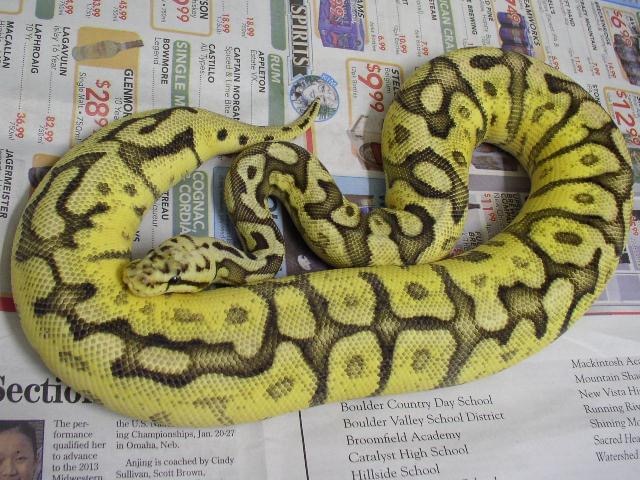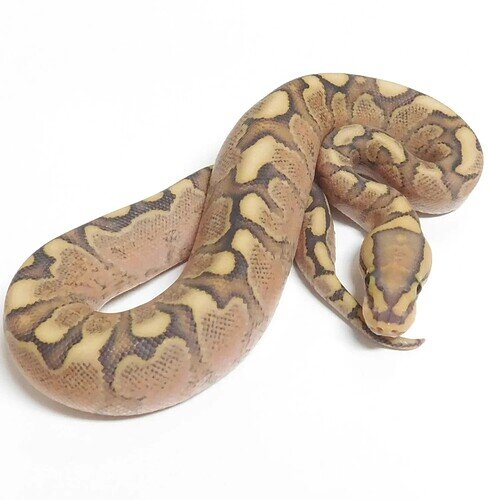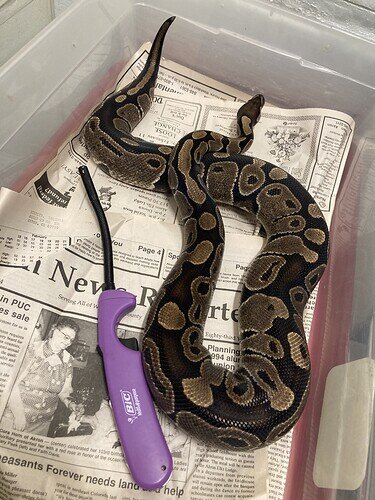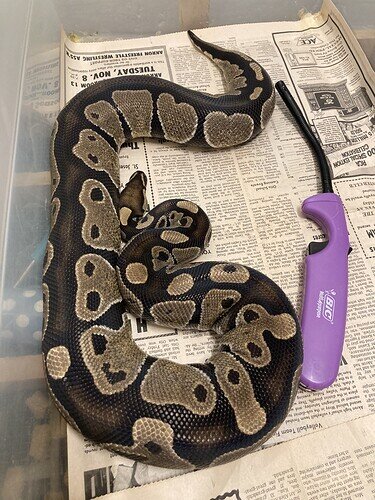So, recently I obtained a big ol spider girl from the next state over in adoption. I’ve noticed that she’s pretty big (about 1,300-1,400g I lost my scale so I’m going to weigh her when I find it. She’s pretty short though sitting at about 3.5 feet and has pretty good body condition) and has little to no wobble, I don’t like the idea of breeding super wobbly snakes so this is one of the only circumstances I’d consider breeding a spider PERSONALLY. I know the parent’s wobble doesn’t really determine the babies’ but I’m more worried about the parents. Either way I’m interested in breeding some spider combos, I kind of want to avoid lower price combos like bumblebee since there’s SO many for sale, so I wanted to look into snakes like Cali bees and fire bees, but more recommendations would really help out since I’m not really up to date what spider combos are popular currently. She has nice high white sides too and gorgeous even patterning so I do intend to take advantage of that for combos. Once I get home I can add some pics! TIA
For co dom morphs I like leopard, Enchi, orange dream. All of those also go well with fire!
I think the first part of what you should do is let her settle in comfortably.
Second… We need a little more information I think.
- is this your only ball python currently?
- is there a reason she was up for adoption, not purchased through a breeder?
- Will you be able to afford long term setups for offspring and possibly be ready to get veterinary care or euthanize if some serious complications arise?
- have you looked into any other combos or is there an animal that you want to produce not just because this happens to be a spider female.
The market is sometimes a bit fickle. It’s tough to say what to breed. The best thing is to really sit back and decide what you would want to see.
It’s a lot easier to ease in that way I think.
Regarding the adoption… You never really know what the history could be sometimes and if she was potentially malnourished or anything previously that may affect her future
Thanks so much for the help and info!
-
This is number 4 but I’m expecting 5 soon, I usually don’t really keep a specific species so I’m considering getting more into it. I also usually do “rescues” but I’m deciding to stay away from that more
-
The main reason is because the person giving her up has had some problems relating to her setup and space in their house since they own so many. She’s actually in very good health and I’m waiting to do tests on her stools and take a closer look at her in general. Almost nowhere near me really sells high quality snakes and anybody near me that sells well loved and well taken care of snakes tends to stay away from spiders, so I wanted to get my hands on her since she’s a beautiful snake and I wouldn’t have to do FedEx shipping for her
-
Yes! I still live with family honestly but I’m staying in the same city during college and I give each and every ball python of mine a 4’x2’x2’ as recommended by many herpetology foundations, professional keepers, and pet guides recommend. My one man is in a 6x2x1.5 right now since he deserves the world. All my snakes also get bioactive enclosures once they’re done with the (generally) 4 month INITIAL quarantine, after that I still wait 2-3 months or I wait to get vet tests in. My room right now can accommodate about 20 4x2x2’s not including my wall dedicated to personal things like my aquariums, desk, and TV.
-
I adore spider combos and I’ve been looking into them for a long while, fate so happened I found this gorgeous girl the first year I’ll be ready to start setting up breeding for next year hopefully, unless I’m ahead of schedule and get ALL my vet tests in and get a lock out of breeding season I’m going to wait, basically just to ensure literally everything goes to plan and for safety reasons I would rather wait until 2024. I’ve been dreaming of getting Cali bees for quite awhile along with nuclear bees, and my opportunities seem to be lining up. Two of my others are a breeding pair too to make OD spotnose pumas but I’m waiting for my female to reach maturity. I have a bit of experience with breeding animals (mainly rodents and insects) but I want to move into reptiles now and I basically only keep snakes since I’ve had them as pets since I was a preschooler, long time ago but I’ve been snake obsessed since I could form memories
I agree on the adoption, I’m hoping that I can get her checked out not only at a vet, my personal lab I keep, but also the herpetology foundation for my state and my cousin who worked with the head of herpetology for the state. I don’t think she was malnourished since the people I’ve gotten her from have raised her since a couple months after birth, currently she honestly seems a bit on the larger end though so I am going to exercising her on a homemade “python playground” I’m working on currently since the weather is still a bit chilly. It’s just a large sanded down dwarf evergreen log with the branches and all, the thing’s 3 decades old and nobody’s done anything with it in the family so I thought attaching it to a rolling cart with hides, vines, and foliage would be a good idea. Also I do plan to let her settle in before I do anything, currently the main messing with her is to make sure her cage parameters are ok and health related checks. Thanks again by the way!

Here is a chocolate pastel spider I produced years ago.
It sounds like you have everything in order then!
It’s a nice change when someone has actually put thought and time ahead into this sort of things, so thank you for that! Especially with the quarantines (as long as your family lets them stay in another room for at least the first 90 days I hope? Or if you have a bathroom attached to your room I’ve had to make that work a few times for sudden rescues @_@;).
I know the 4x2x2’ is the new number that everyone throws around now…but I will say make sure to be a bit open minded on it for what your new baby and future babies may need! A small rack setup can definitely help, especially if you can use 2-3 tub sizes and upgrade as needed. Shoeboxes for hatchlings, go up to 6 quarts… then try something larger or glass front once they’re eating well.
I had one hatchling this year who took almost every trick in the book to get eating on her own…at 3 months old. One older hatchling that I took in as Pet*** adoption who refused to eat frozen thaws and was super scared of glass front enclosures, she’s a tub dweller for sure. Sometimes they get picky, Just roll with the punches.
I personally just picked up a GHI fire spider Orange Ghost. Hoping to cross enchi or OD into that. My first fancy BP is my Killer Queenbee.
OD fireflys are pretty little things. Enchi is also a nice one that helps make spider look more interesting as well IMO. Spider and Pied is something I would avoid unless you like the idea of making the all white pieds/very high white pieds. Obviously be careful of the other wobble morphs as well.
Here’s my new little bugger:
If adopted, I wouldn’t breed at all.
Also many with wobble passes on wobbles and many with hardly a wobble will pass on…
I personally wouldn’t breed a spider.
Honestly, this is not “big”, for a female it is actually quite small. I have 2500-3000g animals
It’s all relative, lol. Took pictures of my two biggest 2020 holdback sisters tonight. The lighter was the only thing around I could think to use for size reference.
But when talking about breeding females that is still the small side. 200 grams over recommended breeding size is still not much. Heck one of my males is over 2,000gr.
According to op though, they’re planning a very extensive quarantine so that will give her time to put on more size before breeding.
I think it’s worth saying that pretty much across the board spider is a gene that, when included in a combo, actually lowers the potential price of that animal. I personally agree with ghoulish and would never breed a spider or a rescue animal (so both is a double whammy) but spider combo ‘popularity’ is ALL over the board and is extremely individually dependent. I’m on MM pretty much every day and I have very consistently observed prices for spider animals getting lower even for proven animals. Spider is a gene that currently creates more negative value in an animal than positive, and there are lots of instances on MM and local shows where clutch siblings without spider sell for more than spider combos with more genes.
What is the reasoning against breeding a rescue?
I know that term is pretty vague as I’ve heard of people “rescuing” animals from pet shops they don’t think are keeping them properly.
A couple of reasons:
You don’t know anything about the animal’s history, either health or genetics, and breeding any animal without that knowledge seems pretty irresponsible. A rescue could have had a number of health issues over the years, have been exposed to any number of contagious conditions or toxic substances, have defects, could have been hatched from a partho clutch, etc. Many rescues have been fed improperly in their past, which is stressful on the body and could have untold consequences on fertility and future offspring (especially as more research comes to light on transgenerational epigenetic inheritance, I would never breed an animal that’s been through major hardship of any type in its life). You don’t know the genetics of that animal, whether it’s hiding other low expression morphs, whether it comes from good lines, whether it’s het for anything and there’s already too many mislabeled, improperly identified or ambigous ball pythons floating around. We really don’t need more.
The goal of selective breeding should be just that - selective. Which means breeding only the best animals (or plants, or whatever your’e working with) to improve the species as a whole. This means carefully selecting healthy, high quality breeding stock for projects, not just breeding any ball python you have at your disposal. Too many people have interpreted the “breed what you love” as “I have this ball python that I love, therefor I must breed it”, when in reality, there’s a lot of snakes that just don’t need to bred.
I would argue that those shouldn’t be bred either, keep them back as pets, but they shouldn’t be the basis of a breeding project.
Agree with most of that, especially the health concerns. But the gambler in me loves the unknown which I’ve noticed most personalities don’t. The whole idea behind African import dinkers is that they might have something unknown. Of course now days a rescue is not likely to have anything you couldn’t buy from a sure source. I did find the original Garcia line chocolate at a pet store way back when there were lots of imported balls.
I personally don’t recommend breeding if you don’t know the history of the animal, for all of the reasons Hilary already mentioned. When you’re buying baby imports from Africa at least you get them as babies and can raise them up and keep an eye on health, but if you’re buying an animal and don’t know where it came from, you risk potential health issues and genetic issues you don’t know about.
I personally have bought two adult animals for breeding - one (flame possible het pied) from a friend who got her in an auction and no longer wanted to keep her, and one (calico) from a pet home where the owner had gone off to college and couldn’t keep her any more. In both cases I bought these animals as adults, not as “rescues” per se but in situations where I didn’t know the exact history of the animal and who they’d been produced by. I planned to breed both of them because I thought they were good examples of their genes and am comfortable IDing genetics. The flame possible het pied female I’ve had for three years now, has been paired every year and shows no signs of building activity but it’s difficult to tell because she is so fearful of humans I can hardly get near her, much less palpate her to check for follicles. She’s rough on males she’s been with and as a result I am no longer breeding her and am looking to sell her to either a pet home or someone with more experienced males and a less stressful environment (basically someone who will never open her bin except to feed). The other female, a gorgeous calico, I thought was a perfectly safe bet given that she was a young adult and had been in what seemed to be a home where she was well cared for. That female locked, ovulated, and then retained her eggs and it has now been over 6 months since her projected lay date, we’ve been in and out of the vet multiple times trying to decide whether surgery was a good option (it’s not, I’m a graduate student and can’t afford a $2k surgery) and she also has suspected kidney disease based on bloodwork done at the vet. So both adult animals I bought thinking they were good deals and could be converted into breeding animals with good gene expression, have not turned out that way at all.
As a result, I don’t plan on buying or breeding anything other than babies I grow up myself going forward. There are too many risks in my opinion when you don’t know exactly where an animal came from. I learned the hard way, and am out quite a bit of money and time because of it (and have grown attached to animals that I now have to rehome or in the case of the calico, possibly euthanize due to health issues). So definitely would 100% agree that it’s not a good idea to breed a rescue animal, whether it’s a “rescue” from a bad situation or just a pet animal you don’t know the history of.
Import dinkers are entirely different from a rescue though.
For one… you need to be experienced to handle making sure any older animals are properly vetted. Any captive hatched import dinkers are considered a fresh bloodlines.
They’re animals for experience breeders to strengthen lines with as they’re less likely to have been inbred for certain morphs. Even if you’re trying to isolate or ID a gene out of them, it takes experience to know what you’re looking for and how to ensure you are still working to better the line.
Taking an actual rescue or ‘rescuing’ cough buying cough a snake from a big box store is the equivalent to someone going, yeah… my dog is a labrador. I found another labrador for sale at the swap meet. I’m going to sell labrador puppies for 300$. You might end up with a couple of beautiful puppies… or they can all have hip dysplacia at 6 months and need doggie wheelchairs.
Thanks for y’all’s help! I’ll probably hold off on breeding her then. At the least I can definitely get every test under the sun done on her though to confirm genetics and her health. I could also touch base with the person I got her from since they’re an exotics keeper who’s had her since she was a baby so hopefully I can fill every box regarding her info! From the info I’ve been given so far and health screening I do know she’s been kept as a pet snake in a 40 gallon for her entire life and she’s never had any confirmed illnesses and only takes black and whit prekilled rats (thankfully I’ll soon have tons, but for now I have a few to feed her) and tends to go on an annual feeding strike around breeding season. I also know she doesn’t have any bacterial or viral infection from my at-home lab but I’m definitely going to get her checked out by a much more experienced person and an actual exotics vet in a couple weeks
This has been my experience as well; most of the combos I’m salivating over lose about 10-20% of their overall value if they have spider genes on top of the better ones.
I debate every time on breaking down and buying a cheaper spider, but tbf I don’t like the morph, I don’t like the wobble, and my wife has banned spiders from our household.
To OP:
We used to have several. All of them were sweet and had great feeding response. BUT they all wobbled. If you think yours doesn’t, you aren’t paying enough attention. (Not all wobble looks the same.) My wife banned them after the last one to leave the house got confused and latched onto their arm, thinking it was a tasty rat.
My wife and I don’t believe in breeding animals that have a heavily questionable quality of life; whether that’s spider ball pythons or French bulldogs, etc.
There are movements to remove the morph from the hobby entirely (some expos in Europe have begun banning it entirely). It’s not fixable with selective breeding (like with French bulldogs), it’s breeding knowing you might have to euthanize those babies when they hatch, the money isn’t as good, and those babies might require special care by future owners.
You do you, but…you should consider a lot more factors these animals will face. Including their deaths.
Ugh. That’s a whole different can of worms too though. Because why just ban spider and not the other wobble morphs?
And then who’s to say we don’t ban any other problem combos?
I only have 1 breeding spider complex in my collection currently (and one hatchling), but a handful of cinny/black pastel and BELs. All can have problems if bred willy nilly.
If it comes down to it …well, I’ll need to start thinning down my breeder groups and think up some new projects I’d want to see.
But I absolutely do agree that you need to be selective and considerate in what you’re breeding. New hobbyists or breeders should not be working with problem morphs off the bat until they have more knowledge under their belt. That’s part of how we got to where we are with some of these genes.
Have a look through listings and sort by trait (spider)availability (sold).
This will give you a idea of the possibilities.
Also world of ball pythons and morphpedia may give you inspiration.


